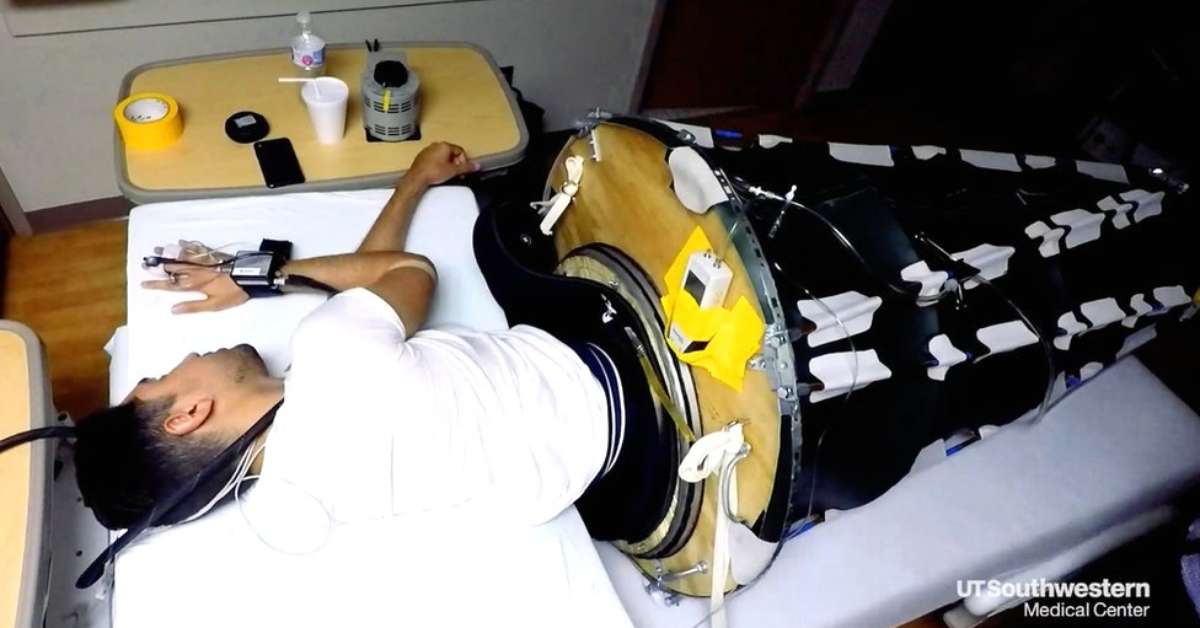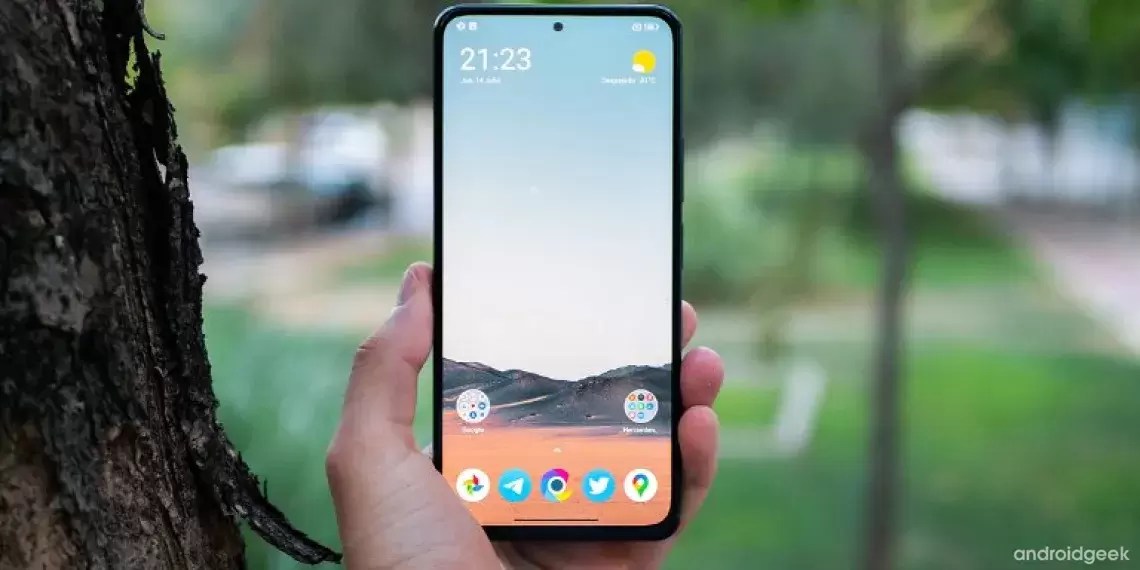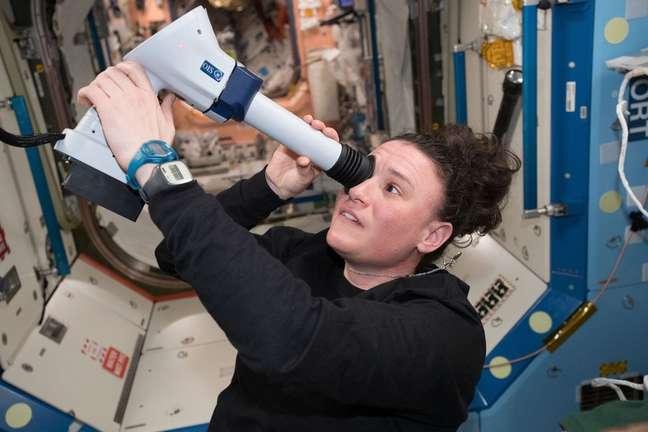Tech
A high-tech sleeping bag that can solve the astronaut’s crushed eyes problem

Scientists have developed a high-tech sleeping bag that could prevent vision problems that some astronauts experience while in space.
In zero gravity, fluids float inside the head and over time squeeze the eyeball. It is considered one of the most dangerous health problems for astronauts, and some experts believe it could interfere with flights to Mars.
The sleeping bag balances the fluid in the head and transports it to the legs, controlling the increase in pressure. It was developed by Benjamin Levin, professor of medicine at the University of Texas Southwestern Medical Center at Dallas. Levin is working to transfer equipment to the International Space Station (ISS).
NASA, the US space agency, has reported vision problems in more than half of the astronauts who have been on the ISS for at least six months. Some had difficulties with vision from afar, with reading, and they needed help in conducting experiments on a space mission.
“We do not know what the consequences of a longer space flight, such as a two-year operation on Mars, could be,” said Levin, who is also the director of Institute of Physical Therapy and Environmental Medicine.
“It would be a disaster if the astronauts were seriously compromised to the point where they could not see what they were doing, which would jeopardize the mission.”
In 2005, astronaut John Philips began his mission to the ISS with normal vision, also called 20/20 vision, and returned six months later with 20/100 vision. A normal eye could see up to 100 meters.
Others had less serious versions of the problem. On Earth, gravity pulls body fluids down every time a person gets out of bed – this is called “unloading.” But in space, low gravity allows half a gallon of bodily fluids to build up in the head, putting pressure on the eyeballs.
This can lead to a condition called space travel neuro-ocular syndrome. (spaceflight-related neuroocular syndrome) or SANS, its abbreviation in English. This, in turn, can lead to progressive flattening of the back of the eyeball, swelling of the optic nerve, and impairment of vision.
“The pressure under zero gravity is always less than the pressure under gravity. But it is not as low as when you are standing. NASA astronauts cannot stand during the flight, ”Levin told BBC News.
constant pressure
Although the pressure on the brain of a person lying on Earth is slightly higher than that of a person lying in space, astronauts experience constant pressure and cannot relieve it by standing upright.
“They never had the opportunity to ‘unload’ (fluid flow) from the brain. So we asked, “Can we reintroduce the gravitational gradient”? – says Levin.
The sleeping bag wraps around the person’s waist, covering the lower body with a strong frame.
The suction device, which works on the same principle as a vacuum cleaner, creates a pressure drop that displaces liquid towards the feet. This prevents the accumulation of fluid in the brain and the “crushing” of the eyes.
Before using this technology, some questions need to be answered, such as how much time astronauts should spend inside the device each day.
“Should everyone do this, or just people who are predisposed to developing SANS? Do you need to do this as soon as you get into space, or can you wait to see if your vision changes? ” – illustrated Levin, talking about the still unanswered questions. “This sort of thing has yet to be determined.”
But Levin says the creation of the sleeping bag means SANS can no longer pose a health hazard in NASA’s future mission to the Red Planet.
People who have had cancer and have survived have played a crucial role in figuring out the causes of this disease. The volunteers still had access to the head, which was used to administer chemotherapy drugs, and this allowed the scientists to measure the pressure in the brain as they spent a few seconds in zero gravity flight simulators.
A dozen more volunteers tested the technology itself. Scientists took measurements while lying with and without a sleeping bag. The researchers found that although three days of lying was enough to slightly reshape the eyeball, no changes occurred when using aspiration technology.
A team of researchers at the Southwestern Medical Center previously discovered that microgravity causes the heart to contract in space, potentially causing a condition called atrial fibrillation, a type of cardiac arrhythmia.
It is possible that a sleeping bag may also help control abnormal blood flow, which increases the risk of mild irregular heartbeats. Research on this has been published in the academic journal JAMA Ophthalmology.

Amateur music guru. Lifelong coffee scholar. Zombieaholic. Pop culture junkie.
Tech
‘My power is really low’: NASA’s Mars Insight rover prepares to launch from the Red Planet
NASA Lander InSight He has delivered what may be his last message from Mars as he embarks on a historic mission to uncover the secrets of the Red Planet’s interior.
In November, the space agency warned that the probe could be running out of time as dust continued to condense and stifle InSight’s power.
“Spacecraft power generation continues to decline as windblown dust accumulates on solar panels,” NASA said in a statement. Update November 2. “The end is expected to come in the coming weeks.”
message shared NASA The InSight Twitter account tweeted on Monday: “My power is very low so this might be the last photo I can upload. Don’t worry about me: my time here has been productive and uneventful. If I can keep talking to my mission team, I will—but I will.” Subscribe here soon. Thank you for staying with me.”
My power is very low, so this might be the last photo I can upload. But don’t worry about me: my time here has been productive and uneventful. If I can keep talking to my mission team, I will, but I’ll sign here soon. Thank you for staying with me. pic.twitter.com/wkYKww15kQ
— NASA InSight (@NASAInSight) December 19, 2022
A geologist robot armed with a hammer and a seismograph first reached the barren expanse of Elysium Planitia in November 2018.
Since then, she has carried out geological excavations, taking the first measurements of earthquakes with a high-tech seismometer placed right on the surface of Mars.
Last month, the solar-powered car released an update to remind us of its time in space.
“I was lucky to live on two planets. Four years ago I made it safely to the second one, much to the joy of my family at first. Thanks to my team for taking me on this journey of discovery. I hope I can be proud of you.”
According to the published mission, Insight has measured more than 1,300 seismic events since it was published, and more than 50 of them had signals clear enough for the team to extract information about their location on Mars. Results.
The probe’s data also provided detailed information about Mars’ interior, liquid core, surprisingly variable remnants beneath the surface of an extinct magnetic field, climate and seismic activity.
old for Its launch in 2018NASA Chief Scientist Jim Green said the mission was “fundamental to understanding the origins of our solar system and how it became what it is today.”
NASA will not declare the mission complete until Insight confirms the arrival of two spacecraft orbiting Mars that are relaying their information back to Earth.
In 2018, the veteran rover announced the capabilities end of his 15 year stay Sending an incomplete photo of the Valley of Perseverance.
A severe dust storm darkened the sky around the solar-powered rover, shattering the sun and leaving behind a dark image with white spots due to camera noise. The transmission is interrupted before the complete image can be transmitted.

Amateur music guru. Lifelong coffee scholar. Zombieaholic. Pop culture junkie.
Tech
What’s new on February 7, 2023

Being very close companies, OPPO and OnePlus have decided to create a new partnership, with the latter being a pioneer in the market. It has become the representative of the best smartphones in the group, and this will be seen very soon.
Proving this, OnePlus has announced that it will have news soon. The following brand assets will be announced on February 7, 2023. We are talking about OnePlus 11 5G and Buds Pro 2.
In recent years, OnePlus has been showcasing new hardware in an attempt to find a new place in the market. The brand has not always seen its full potential, betting on mid-range or entry-level smartphones.
The situation is changing, and the novelty will go on sale in early 2023, February 7. It is on this day that the new OnePlus 11 5G will be presented with all the expected news. We definitely have the new Qualcomm Snapdragon 8 Gen 2 SoC here. There's still 16GB of storage left and 256GB of onboard storage.
It is expected that he will receive a 6.7-inch OLED display with a resolution of 1440p and a frequency of 120 Hz. In the field of photography, we will have an important change: a 50 MP main camera, a 48 MP ultra wide-angle camera and a 32 MP telephoto lens with 2x zoom. For selfies and video calls, you'll have a 16-megapixel camera.
The photography partnership with Hasselblad will continue with OnePlus for fine-tuning and some additions. This alliance has brought important results for the best smartphones of the brand, guaranteeing the best photos in any situation.
In addition to the new OnePlus 11 5G, another brand new feature is also expected to arrive at the event. We're talking about the Buds Pro 2, which are solidifying an audio commitment that's becoming more of a reality. The brand promises "rich stereo quality sound with crystal clear clarity".
Stays like this marked by the beginning of February, another important novelty will enter the market. OnePlus wants to reclaim its place, and that will be the brand's bet for years to come. OnePlus 11 5G and Buds Pro 2 take the first step in this direction.

Amateur music guru. Lifelong coffee scholar. Zombieaholic. Pop culture junkie.
Tech
New POCO Smartphone Seen in Certification May Debut Soon

According to information provided by Mukul Sharma, the unidentified POCO device can be identified by the model number 22127PC95I. Due to the fact that it was first seen online, the marketing name of this equipment is still a mystery.
POCO has not launched new mobile devices, including smartphones, to the market for some time now. On the other hand, several POCO smartphones such as POKO X5 and X5 Pro have been spotted on various certification sites, suggesting that the company will release these products soon. Today a new smartphone from the sub-brand xiaomi has been spotted on the BIS India website but the device does not have a name or any other details associated with it.
A new POCO device (model number 22127PC95I) has been included in the Indian BIS certification. POCO F5 has the model number 23013PC75I. #A LITTLE pic.twitter.com/NAFloP5Crt
— Mukul Sharma (@stufflistings) December 19, 2022
According to information provided by Mukul Sharma, the unidentified POCO device can be identified by the model number 22127PC95I. Due to the fact that it was first seen online, the marketing name of this equipment is still a mystery. It is possible that it will debut as a mid-range smartphone. The Bureau of Indian Standards (BIS) website, other than the model number of the smartphone, does not provide any additional information about the device. However, this seems to indicate that the product will be available in the Indian market very soon.
In other related news, POCO X5 5G has recently been seen on several certification sites including SIRIM in Malaysia, BIS in India and the US FCC. According to various sources, it is possible that this is a renamed or modified version Redmi Note 12 5Gwhich was recently released in China.

It is supposed to be equipped screen 6.67″ AMOLED display with 120Hz refresh rate and chipset Snapdragon 4 Gen 1 inside. Can run MIUI 13 based on android 12 and have LPDDR4x RAM in addition to UFS 2.2 storage. The front camera is rumored to be 8MP while the main rear camera will be 48MP with 2MP depth. May have the ability drums 5000 mAh and 33W fast charging support.
In addition POCO X5 Pro 5G has recently been seen on various sites dedicated to certification. The battery is said to have a capacity of 5000 mAh and can charge at 67W. It will come with MIUI 14 preinstalled and will support n5, n7, n38, n41, n77 and n78 network bands. 5G.
 Every day we bring you dozens of news from the world of Android in Portuguese. Follow us on Google News. Click here and then on “Subscribe”. Thank you! Every day we bring you dozens of news from the world of Android in Portuguese. Follow us on Google News. Click here and then on “Subscribe”. Thank you! |

Amateur music guru. Lifelong coffee scholar. Zombieaholic. Pop culture junkie.
-
World4 years ago
The Gabby Petito case. Brian Landry set up camp with his family after his girlfriend disappeared
-
Top News5 years ago
Tristan Thompson reacts to Khloé Kardashian’s new appearance
-
Economy2 years ago
Everything has been delivered. 10 Bugatti Centodieci are already in the hands of the owners
-
Top News5 years ago
TLC ‘sMothered’ recap: ‘Party curled up,’ boyfriend problem
-
Top News5 years ago
Alex Cooper hosts a solo podcast
-
Top News5 years ago
2021 Ford Bronco price: Here’s how much the 2-door and 4-door cost
-
Tech5 years ago
Fall Guys is supplying out a legendary costume and Kudos as an apology present
-
Top News5 years ago
Chiara de Blasio was ‘very cold’ during the arrest of the protest: witness














